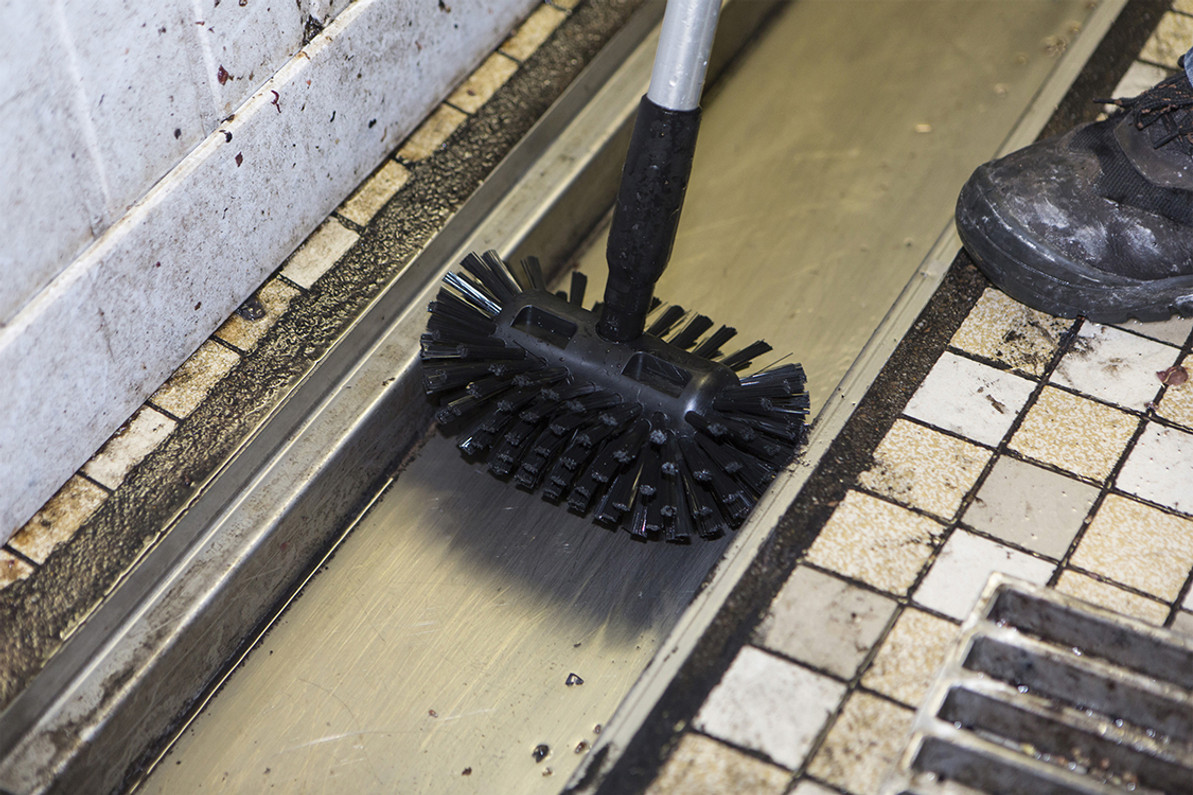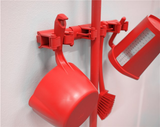Preventing Listeria in your Brewery or Food Processing Drainage System
It is estimated that 30% of drains in food and beverage production facilities test positive for Listeria. Is Listeria lurking in your Brewery or Food Processing Plant floor drainage systems?
What is Listeria?
In the past 20 years, Listeria Monocytogenes has become a major concern to the food industry. The CDC estimates that Listeria is the third leading cause of death from foodborne illness, or food poisoning, in the United States. Each year, 1,600 Americans contract listeriosis. It is usually contracted from eating contaminated, ready-to-eat foods such as salads, raw fruit and vegetables, but it also comes from deli meats, sushi, smoked fish and seafood, raw milk, unpasteurized cheese and ice cream. Of all the known foodborne pathogens, it has one of the highest mortality rates at 20% (1 in 5). Pregnant women, newborns, and the elderly are especially vulnerable to infections. Symptoms range from mild, flu-like illness to severe blood poisoning and meningitis.
Where Does Listeria Come From?
Listeria bacteria are very common in the environment and can be found in soil, water, sewage, animal guts and feces, and on raw foods. Therefore, the bacteria can easily be introduced into and spread throughout food production facilities. One surprising fact is that listeria thrives in cold environments, including freezing temperatures, meaning refrigerated and frozen foods are still at risk. Ready-to-eat food processing environments that are chilled provide the nutrients and moisture required for Listeria growth. Foods contaminated with listeria do not look, smell or taste any differently. Listeria can grow into biofilm, attaching to dark, wet surfaces like floors, drains and equipment, making them more difficult to remove during cleaning and the source of cross-contamination.
The Five Most Common Places Where Listeria is Found
Food processing facilities focus their sanitation efforts on surfaces that come into contact with ready-to-eat (RTE) food, and rightly so. This presents the highest risk to the consumer. These areas must be kept sanitary, and employees must be well-trained to wear protective clothing/gloves and use hygienic utensils and containers. Personal hygiene and protective wear are so important, therefore, when handling open food, consider using protective gowns, aprons and sleeves so that clothing will be clean. Having said that, Listeria is often found in unexpected places that don’t get as much attention during cleaning and sanitation:
- Floors Listeria Monocytogenes is present all around us, mainly on dust on the ground. This means that proliferation of Listeria is most of the time done via shoes and boots. Ensuring that employee shoes and boots are clean in the susceptible areas of the facility is a prerequisite. Using plastic overshoes or shoe covers are less advisable as the plastic can rupture and expose risk or outside dirt can settle on top of the plastic. It is equally important to keep your facility floors dry at all times. Listeria bacteria needs water to grow and sustain. Proper water management in your facility will ensure water drains properly. Investing in the correct tools like
- will help remove standing water from around equipment and transfer hoses after wash-down.
- Drains One of the most popular locations for Listeria Monocytogenes is floor drains due to prevalence of standing, dirty water. It is estimated that 30% of drains in food & beverage production facilities test positive for Listeria. If you use a pressurized washer to clean your drains, the water blast carries the Listeria through the air and onto your equipment. A clogged or flooded drain can lead to a pool of contaminated water on your production floor. Employees can spread Listeria to clean areas by walking over contaminated trench drain grates. Cross-contamination occurs when your staff uses brushes and buckets on your equipment after cleaning floor drains.
- Ensure you invest in hygienically designed drains and regularly clean and sanitize them to prevent bacteria from thriving. We offer a full line of
- that fit slot drains or trench drain grates. They are color-coded and labeled to prevent your staff from using them on food preparation surfaces or equipment.
- Processing Equipment Obviously, your highest risk for exposure is around your processing equipment where there is direct food contact. It is important that your clean in place (CIP) system be free of obstruction and all surfaces be smooth so it can properly sanitize the equipment. Pay special attention to hard-to-reach areas including poorly drained open equipment frameworks, hollow unsealed rollers, poor welds, spaces inside slicing machines, and areas under covers and guards. The golden rule is to keep water away from your product at all times.
- are an excellent tool for keeping surfaces dry, they are color-coded for HACCP food safety plans, and they are safe for food contact. You should never use high pressure water spraying systems near your food preparation as they give rise to aerosols (small drops of water floating in the air) being formed which may carry bacteria. Our full line of
- comes with variable spray and low flow options.
- Freezer / Cooler System It is important to keep the fans and evaporation plates of your freezers and cooling systems clean and sanitized at all times. Listeria can survive very low temperatures and even grow at temperatures as low as 23˚F / -5˚C. Your sanitation / cleaning product supplier should have specialized products for cleaning cooling and freezer systems.
- Air Handling Systems There is a high likelihood that water will build up in your air handling ducts and vents due to condensation. Give your system an inspection after cleaning the facility to mitigate the build-up of water which could lead to Listeria bacteria growing. We offer a
- that is purpose-built for removing/capturing built-up condensation from overhead ducts.
Important FSMA Regulations
The FDA provides guidance for controlling Listeria in food production facilities, including breweries. You need to be aware of these regulations in the eventual case that you are audited. Good Manufacturing Practices (GMPs) require that you have sanitary operations that include properly cleaning non-food contact surfaces (floors, ducts, drains). The Equipment and Utensils category covers using sanitary cleaning and handling tools (i.e., brushes and squeegees) to prevent cross contamination. The Plants and Grounds category covers a proper drainage system. Among their recommendations for trench drains:
- Employees who clean drains should not handle food or touch food preparation surfaces unless they first change their uniforms and footwear, wash and sanitize their hands, and put on clean gloves
- Maintenance personnel in food production areas should follow the same hygiene requirements as production employees
- Carefully design trench drainage systems to eliminate the chances of standing water and backups
- Design drains so that they are accessible for cleaning and prevent bacteria growth; 100% stainless steel slot drains with smooth edges reduce biofilm contamination and remove places for bacteria to hide/grow
- Clean and sanitize floor drains in a way that prevents contamination of other surfaces in the room
- If a drain backs up and water flows into food preparation areas, stop food production until you fix the drain and clean the area
Mitigate the Risks of Listeria
There are a number of reasons why you want to reduce your exposure to Listeria including consumer/employee safety and the potential damage to your business/brand after a food safety recall. The good news is this is very preventable with a food safety plan that includes the following:
- Invest in hygienic, color-coded buckets, brushes, floor squeegees, and drain brushes to minimize cross-contamination by segmenting zones
- Make sure all of your floor cleaning equipment such as floor scrubs, squeegees and drain brushes are cleaned and dipped in sanitizer after use to ensure that any bacteria is killed and does not spread. Surveys show that up to 47% of cleaning equipment in food-processing areas test positive for Listeria (Campden BRI, 1990).
- Hang and store your cleaning tools off the floor so that they dry properly and do not harbor bacteria
- Train your employees to use personal hygiene and protective wear/boots
- Design your facility such that the drainage systems are adequate, sanitary and easy to clean
- Consult your sanitation / cleaning product supplier for the proper products for sanitizing your drains, floors, cooling systems and air ducts.
YOUR PARTNER IN COMPLIANCE
Union Jack is here to help you with FSMA compliance by providing quality cleaning and handling tools, and containers for your brewery or food processing facility. Check out hand selected products in the Brewery section and Food Processing section of our website.
Union Jack
Keeping it Clean Since 2006
Recent Posts
-
Enhancing Food Safety with Proper Tool Care, Maintenance & Storage
Proper care, maintenance and storage of food contact tools is critical for ensuring a sanitary and c …Jun 29, 2025 -
Ergonomic Cleaning & Material Handling: Why Tool Design Matters
Safety, efficiency and comfort are important factors when it comes to cleaning and material han …Mar 09, 2025 -
Save with Quality Replacement Parts
Here at Union Jack, we want to ensure you will get the longest life out of your tools and the most …Sep 17, 2024




